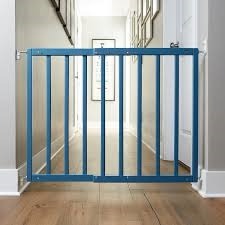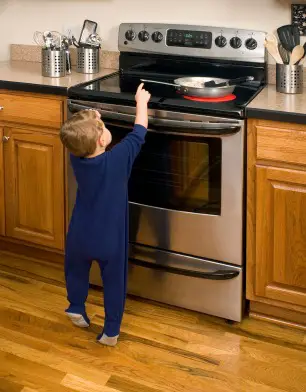There are lots of benefits that come with letting kids get involved in the food preparation and cooking process.
To start with, it is an enjoyable way of learning together and bonding.
Second, food preparation and serving is an amazing way of building children’s self-esteem. It also boosts confidence throughout their lifetime.
In addition, it will help increase the probability of having children eating healthy nourishing foods as opposed to feeding on junk food.
If you and your kids have never cooked together, you might be worried about safety in the kitchen. Knowing the various ways to involve your little ones safely and joyfully, will help in easing your worries.
Learning about readiness for oven use, correct handwashing, and age-suitable skills, handling of food items and safe handling of sharp objects or breakables in the kitchen will lead to peaceful and fun mealtimes for everyone.
The kitchen is the focal point of family life; however, it is an area that poses lots of hazards and therefore very accident prone.
Yearly, 42,000 kids below 5 years get admitted to hospital because of kitchen accidents.
Safety Considerations with Children in the Kitchen
However, with some safety considerations and easy changes, you will keep the kids safe.
Keep the following safety tips in mind while involving your children in the kitchen to avoid accidents:
Breakages and spills

Avoid cuts and slips by clearing spills and breakages right away. If there’s broken glass, remember that small sharp shards will disperse across a broad distance.
For this reason, always shut your little one out of your kitchen until you have done a thorough clean-up of all the breakages.
Also, ensure your child wears slippers or shoes for the next couple of days after a breakage before entering the kitchen and do not allow your child to touch the floor with their hands
Kitchen drawers and cupboards
Naturally, children show curiosity, so it is best if you fit locks on cupboard drawers and doors to help in keeping objects, like razor-sharp knives, unreachable.
Some of the popular types of locks are plastic and push down locks; however, they may lose their shape in the end.
Some kids ultimately discover how to open these locks, so you do not take for granted that simply because you have installed locks, the drawers are off-limits.
Hot drinks and pans
Never put your hot drinks, bowls of hot drinks or hot pots and pans near the edge of countertops, where your baby may pull them over.
Curious babies will often reach out to find out the contents of any containers they can reach. Hot pot and pan handles should always face away from pathways and reach of children.
Stay away from the oven and hob
The oven and hob are danger hot spots, so you should train your little one these areas are off-limits. Make sure you use the hob’s back rings and turn the pot handle so that they are facing away from the front.
This is to ensure a child cannot grab them or get knocked by you. Stove-top guards will function as a blockade to little hands and heat.
For this reason, attaching an oven guard to the front will help in minimizing the surface heat by half. Another helpful device is locks fitted to your oven door.
Electric items
It is best to use bread ties to keep electric flexes wrapped up and put away. These items hold them, or you can use coiled flexes as well.
If you are purchasing new appliances, get models that have child-safe feature, like cool wall toasters and kettles.
Make sure you keep electrical items having sharp parts, like food processors hidden. In addition, use child-proof covers for protecting sockets when not in use.
Chemicals

Yearly, more than 28,000 kids get treated for poisoning incidents, and kitchen cleaners are a popular cause. Make sure you keep all the chemicals put under lock and key, hidden from kids.
Other things to lock away are glass items, boxes with saw-like edges (like aluminium foil or cling paper) and plastic bags.
If you’re not limited with space, make sure you fit an appropriate lock to the trash bin’s lid as well or store the bin inside a locked cupboard.
Climbing dangers
Position chairs under your kitchen table, and if you are preparing food with your little one, don’t leave the child standing on a chair while stepping out of the kitchen.
It will only take a second for the child to grasp for a likely danger, that’s previously been off-limit.
In addition, don’t leave your child in the bouncy chair or car seat in the office or on the table. The reason being, as the child makes more movements, he or she might start rocking the seat towards the edge and hit the floor.
Fire safety
Always keep a fire blanket and fire extinguisher nearby, and fit a smoke alarm to help detect any fire in good time. Ensure that you always keep matches and lighters off limit as well.
Stair gates

While it is best to involve your little one in cooking, sometimes, you might have to keep your kitchen off-limits; for example, when you are removing hot food out of your oven.
Using a playpen in your room, or having the kitchen door fitted with a stair gate, will help you watch over your child. It also allows you to keep your little one away from the potential danger.
To make sure your child is safe, it is crucial that you train them all the above safety measures in addition to:
- Know how to treat a cut, burn, or other injuries. Basic first aid knowledge can save lives.
- When you’re using the microwave, train your little one how to mix and stir the heated food items before tasting it. Microwaved food items may warm up unevenly, and stirring will help in distributing heat evenly throughout your dishes and prevents hot spots.
- Always use a potholder to get food items out of your microwave; this will protect your hands from burning.
- Never leave your kitchen while you’re cooking.
- Teach your kids to use an apron to protect from spills, boiling water, grease, and splatters.
- You should not leave cooking pots on the fire unattended. Teach your kids the difference between perishable and non-perishable foods. Some items that you should refrigerate include eggs, cheese, meats, yoghurt, milk, etc. This will reduce the risk of consuming bad food which can result to food poisoning or other stomach illnesses.
- Ensure kids know how to use a fire extinguisher, to call 911 and, how to extinguish a fire.
- Make sure you wear footwear in your kitchen for protection from burns. Footwear is also important after you have had any glass breakages in the kitchen.
Other ways of getting your children involved safely
Other effective and safe ways of getting your kids involved in cooking are having them help with the entire process.
This means that you get them involved throughout the full cycle from planning, to shopping, to preparing, to cooking, serving and even cleaning up thereafter.
You can begin by bringing your children to the grocery and have them select different veggies and fruits.
Endeavor to select different shades in every group and try out those food items. Additionally, you can have the kids participate in creating a weekly menu plan.
Remember to show them how to set the table, clear the table, and clean up the dishes.
The more the kids become independent, the less stressful eating time can be, the more the kids’ diet will have variety, and the more fun there will be for the whole family.
Conclusion
Getting your kids involved in preparing food is a great way of developing lasting life skills.
This cannot only help in improving nutrition, but will also help in minimizing mealtime stress, boosting confidence, and forming the perfect bond between parent and child.
It might look like a difficult undertaking; however, it does not have to occur overnight. All through the lifespan of your child, there will be opportunities for introducing various skills effectively and safely.
Always, make sure you teach your children the right safety precautions. Also, allow the kids to progress slowly as they gain mastery in skills appropriate for their age.

